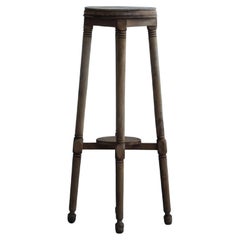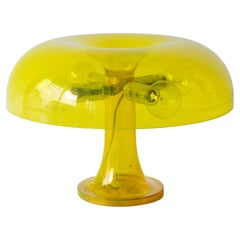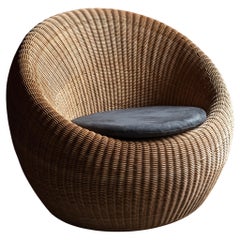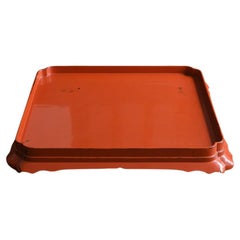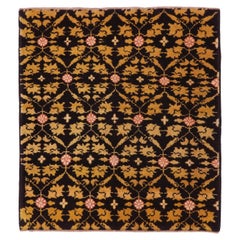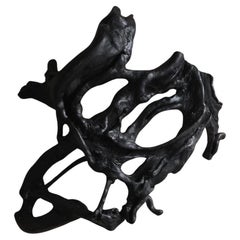Japan - Furniture
to
548
508,965
446,303
1,986
1,325
26
187
137
109
10
8
4
3
3
2
2
1
1
138
384
1,464
1,351
458
517
271
7
8
13
22
26
107
112
84
76
23
1,116
831
785
764
763
2,743
1,927
1,889
707
706
3,337
3,244
3,278
289
58
41
34
33
Item Ships From: Japan
Antique flower stand, Wabi-Sabi, Japandi
Located in Katori-Shi, 12
A cherry wood lathe-legged stand from the Taisho period with beautiful delicate decorations.
It features graceful lathe legs and a round tabletop, making it a rare piece that is har...
Category
Early 20th Century Japanese Taisho Japan - Furniture
Materials
Wood
Artemide Nessino Giancarlo Mattioli transparent yellow Y2K design
By Giancarlo Mattioli, Artemide
Located in Shibuya-ku, Tokyo
Masterpiece table lamp of Space Age design.Original was released from the 60s by Artemide. It is transparent model released only from the late 90s until 2000s. It's improved design ...
Category
1990s Italian Space Age Japan - Furniture
Materials
Plastic
Rattan Lounge Chair by Isamu Kenmochi for Yamakawa Rattan, 1960s
By Isamu Kenmochi
Located in Tokyo, Tokyo
A sculptural rattan lounge chair designed by Isamu Kenmochi and manufactured by Yamakawa Rattan in Japan.
This iconic design is distinguished by its smooth, organic form and tightly...
Category
1960s Japanese Vintage Japan - Furniture
Materials
Rattan
A large square tray made of Japanese antique lacquer / Late Edo period/19th
Located in Sammu-shi, Chiba
These trays were made after the late Edo period in Japan (after 1800).
This particular type of tray is known as "Negoro-bon."
Negoro lacquerware is a specific style of Japanese lacqu...
Category
19th Century Japanese Edo Antique Japan - Furniture
Materials
Lacquer
Ararat Rugs Mamluk Wagireh Rug with Flower Lattice Design Natural Dyed Carpet
By Ararat Rugs
Located in Tokyo, JP
The design source of the carpet comes from the book Völker, Angela, Die orientalischen Knüpfteppiche das MAK, Vienna: Böhlau, 2001: 42–5. This rug with the central star was designed ...
Category
21st Century and Contemporary Turkish Revival Japan - Furniture
Materials
Wool, Natural Fiber, Organic Material
Old Japanese root tree object/Wall ornament/Wall decoration
Located in Sammu-shi, Chiba
This is an old Japanese wooden object.
It is carved from the root of a tree.
I believe it was made from the late Showa period to the early Heisei period.
The wood was originally a li...
Category
Mid-20th Century Japanese Showa Japan - Furniture
Materials
Wood
Japanese Painting, 17th Century, Tale of Genji, Tosa School
Located in Kyoto, JP
Illustration to an unidentified chapter of the Tale of Genji (Genji Monogatari)
Tosa School (second half of the 17th Century)
Ink, pigment, gofun and...
Category
Late 17th Century Japanese Edo Antique Japan - Furniture
Materials
Gold Leaf
Japanese old wabi-sabi appreciation stones/water stones/scholar stones
Located in Sammu-shi, Chiba
Suiseki is a traditional Japanese viewing stone, admired for its beautiful natural shape. The name "Suiseki" combines the words "water" and "stone," reflecting the tradition of pouri...
Category
20th Century Japanese Showa Japan - Furniture
Materials
Stone
Mid 19th Century Japanese Screen Pair. Flowers & Birds of the Four Seasons.
Located in Kyoto, JP
Shioka Sorin (1781-1850)
Flowers & Birds of the Four Seasons
Pair of six-panel Japanese Screens. Ink, gofun and pigments on silk.
Dimensions (each screen): H. 91.5cm x W. 285cm (3...
Category
Mid-19th Century Japanese Edo Antique Japan - Furniture
Materials
Silk
Lamperti wall lamp yellow Italian modern 70s
By Lamperti
Located in Shibuya-ku, Tokyo
Vivid color wall lamp named "Lucciole." Yellow steel shade is able to tilt and turn.
Set of two wall lamps in yellow.
Light source E27 light bulbs.
Using with 100-120V Able to use...
Category
1970s Italian Mid-Century Modern Vintage Japan - Furniture
Materials
Steel
19th thick black lattice door. antique sliding door. wabi sabi Japanese shoji
Located in 常陸大宮市, JP
Japanese antique thick lattice sliding door, ara-koshido.
Edo to Meiji period circa 1870s to early 1900s.
Nowadays it's getting harder & more rare to find a sliding door with thick,...
Category
Late 19th Century Japanese Edo Antique Japan - Furniture
Materials
Wood
$600 Sale Price
20% Off
Japanese antique wood carved Buddha/1800s/late Edo period/folk Buddha
Located in Sammu-shi, Chiba
This is a wooden Jizo Bodhisattva statue made in the late Edo period in Japan.
It is thought that they were not carved by Buddhist sculptors living in central cities such as Kyoto or...
Category
19th Century Japanese Edo Antique Japan - Furniture
Materials
Cypress
Japanese Antique Stool Chair Chestnut wood Primitive Wabi-Sabi Japandi
Located in Chiba, Chiba
This is an old Japanese stool.
All made from solid chestnut wood.
This item was found in the Tohoku region and appears to have been made by an individual in the past.
The seat of the...
Category
Early 20th Century Japanese Primitive Japan - Furniture
Materials
Wood
Vintage Old Bessarabian Kilim Rug, Moldovan Moldavian Romanian Bulgarian Carpet
Located in Tokyo, JP
This is a Vintage Old Bessarabian Kilim Rug from Moldova with a rare and beautiful color composition.
Today it is a landlocked country in Eastern Europe, bordering Romania and Ukrai...
Category
Late 20th Century Moldovan Kilim Japan - Furniture
Materials
Wool, Natural Fiber
$864 Sale Price
20% Off
Japanese Contemporary Black Gold Silk Brocade Two-Panel Folding Screen
Located in Takarazuka, JP
Exceptional Japanese contemporary two-panel "byobu" or folding screen featuring two graceful ladies dressed in elegant formal traditional Japanese kimonos. This folding screen is ins...
Category
21st Century and Contemporary Japanese Meiji Japan - Furniture
Materials
Gold
19th century Japanese Wood Carving Temple Shrine Sea Breams and Wave Decoration
Located in Chiba, JP
SEA BREAMS AND WAVES – Wood carving decoration with the remains of original bule paint as the actual fragment of a certain Japanese temple/shrine construction, Edo-Meiji period, 19th...
Category
Late 19th Century Japanese Japonisme Antique Japan - Furniture
Materials
Wood
Antique Mucur 'Mudjar / Mujur' Prayer Rug, Turkish Central Anatolian Carpet
Located in Tokyo, JP
This is an antique Mucur Rug from Central Anatolia, the Kirsehir region with a floral pattern, good condition, and beautiful color composition.
The town of Mudjar (or Mucur) is a...
Category
Early 20th Century Turkish Oushak Japan - Furniture
Materials
Wool, Natural Fiber, Organic Material
Japanese Large Red Silk Brocade Gilded Two Panel Folding Screen
Located in Takarazuka, JP
Exquisite contemporary Japanese two panel folding screen or "byobu" featuring genryoku style handcrafted silk raised kimono in cream and gold needlework on a mesmerizing red background. Tagasode is the way a genryoku kosode kimono is hung over a kimono rack...
Category
21st Century and Contemporary Japanese Japan - Furniture
Materials
Gold
Chinese antique white pottery vase/17th century/excavated vase/
Located in Sammu-shi, Chiba
A Chinese vase made in the late Ming to early Qing dynasty (1600s).
It was made in southern China (Fujian Province).
It is an excavated item.
In Japan, it is called an "anpin" vase.
...
Category
17th Century Chinese Ming Antique Japan - Furniture
Materials
Pottery
Japanese Screen Painting, Early 19th Century, Autumn Flowers by Sakai Hoitsu
Located in Kyoto, JP
A two-fold Japanese screen by the Rimpa school artist Sakai Hoitsu (1761-1828), Japan, 19th century, Edo period.
This small Japanese folding screen pai...
Category
Early 19th Century Japanese Edo Antique Japan - Furniture
Materials
Wood, Silk
Wooden Coat Rack / Reproduction of European Hanger Rack
By Japanese Studio
Located in Sammu-shi, Chiba
Wooden coat rack inspired by an antique display fixture from a French boutique.
The combination of brass pipes and wood is beautiful.
Made to order (de...
Category
2010s Japanese Modern Japan - Furniture
Materials
Brass
Vintage & Old Kilim Cushion Cover, Anatolian Yastik Turkish Modern Pillow 4326
Located in Tokyo, JP
We made a cushion cover using the undamaged part of the precious and high-quality old & antique kilims that cannot be repaired as a whole. Like a painting, a part of the scenery is c...
Category
2010s Turkish Kilim Japan - Furniture
Materials
Natural Fiber, Organic Material
$120 Sale Price
20% Off
Nikkō and Gakkō Bodhisattvas Temple Bell, Bunsei Era 1822
Located in Fukuoka, JP
This remarkable Buddhist temple bell is an authentic piece of spiritual history, cast in 1822, during the Bunsei era. Adorned with the august symb...
Category
19th Century Japanese Edo Antique Japan - Furniture
Materials
Bronze
Vintage Borujerd Lorestan Village Rug Lori Carpet Northeast Persian Hand Knotted
Located in Tokyo, JP
This is a Northeastern Persian Borujerd Style Carpet from the Lorestan region with a rare and beautiful color composition, featuring a red, blue, and salmon color scheme. Its foundat...
Category
Mid-20th Century Caucasian Oushak Japan - Furniture
Materials
Wool, Natural Fiber, Cotton
$704 Sale Price
20% Off
Ararat Rugs Village Rug, Antique Anatolian Turkish Revival Carpet Natural Dyed
By Ararat Rugs
Located in Tokyo, JP
The source of the rug comes from the book Orient Star – A Carpet Collection, E. Heinrich Kirchheim, Hali Publications Ltd, 1993 nr.172. This is a unique, lacking formal arrangement d...
Category
21st Century and Contemporary Turkish Revival Japan - Furniture
Materials
Wool, Natural Fiber, Organic Material
Japanese Antique Open shelf (2), Wabi Sabi, Japandi
Located in Katori-Shi, 12
This open oak rack has no back panel and is shaped only by structural lines.
Even with its clean, straight lines, the corners are slightly chamfered, highlighting the soft texture o...
Category
Early 20th Century Japanese Taisho Japan - Furniture
Materials
Wood
Carl-Harry Stalhane / Unique Jug / Rorstrand / 1962
By Carl-Harry Stålhane, Rörstrand
Located in Shibuya-Ku, JP
Unique piece by Carl-Harry Stalhåne, who led Rorstrand’s golden age in the 1950s.
Rörstrand’s art pieces come in three types: one-of-a-kind unique pieces, limited editions, and seri...
Category
1960s Swedish Scandinavian Modern Vintage Japan - Furniture
Materials
Stoneware
Japanese Vintage Drawer, Early Showa Period '1926-'
Located in Hitachiomiya-shi, 08
This vintage drawer was crafted in the Early Showa Period '1926-'.
Made of cedar wood, it is solidly constructed and shows the beautiful signs of aging. The surface of the wood has...
Category
Mid-20th Century Japanese Showa Japan - Furniture
Materials
Cedar
A tasteful wooden bowl from Southeast Asia / 20th century / tray-shaped object
Located in Sammu-shi, Chiba
This wooden bowl is believed to have been made in Southeast Asia around the 20th century. It was owned by a Japanese antique collector, and its rugged yet warm shape is impressive.
...
Category
20th Century Japanese Other Japan - Furniture
Materials
Wood
Japanese Tabletop showcase with lathe legs , Japandi
Located in Katori-Shi, 12
"CHARM" is an original ICCA product, a diagonal cut tabletop showcase with potter's wheel legs.
The delicate, straight potter's wheel legs and neatly beveled edges.
The carefully a...
Category
2010s Japanese Taisho Japan - Furniture
Materials
Wood
Ararat Rugs Sailer Sarkisla Carpet 17th Century Anatolian Revival, Natural Dyed
By Ararat Rugs
Located in Tokyo, JP
The source of the rug comes from the book Orient Star – A Carpet Collection, E. Heinrich Kirchheim, Hali Publications Ltd, 1993, no. 214. This is a series of medallions-designed rugs...
Category
21st Century and Contemporary Turkish Oushak Japan - Furniture
Materials
Wool, Natural Fiber, Organic Material
Yamaha Casette Deck Mario Bellini
By Yamaha, Mario Bellini
Located in Shibuya-ku, Tokyo
Yamaha casette deck designed by Mario Bellini in 1974. Working with 100V or DC12V.
Historical audio equipment which is one of MOMA permanent collection.
Inclined body has control panel...
Category
1970s Japanese Mid-Century Modern Vintage Japan - Furniture
Materials
Plastic
Kyllikki Salmenhaara / Creamer / Arabia Art Department 1950s
By Kyllikki Salmenhaara, Arabia of Finland
Located in Shibuya-Ku, JP
Kyllikki Salmenhaara was Finland's most accomplished ceramic artist, who refined her exceptional pottery skills into an art form, as well as a researcher and educator who devoted her...
Category
1950s Finnish Scandinavian Modern Vintage Japan - Furniture
Materials
Ceramic
Flower Wall Art Norihiko Terayama A1
By Norihiko Terayama
Located in Shibuya-ku, Tokyo
Title: Artificial and dried flowers that were arranged
Unique wall art by Norihiko Terayama. Small cut out piece of artificial flowers and dried flowers are stuck with needles in goo...
Category
2010s Japanese Modern Japan - Furniture
Materials
Wood
Wooden Flower Stand, Japanese Antique, Wabi-Sabi, Mingei
Located in Katori-Shi, 12
This is an antique wooden flower stand from the Meiji period.
At the time, it was used as a workbench by craftsmen.
There are small marks on it, probably from using a hammer.
A clo...
Category
Early 20th Century Meiji Japan - Furniture
Materials
Wood
17th Century Japanese Screen. Karako Asobi: Chinese Children at Play.
Located in Kyoto, JP
Anonymous Kano school artist
17th century
"Karako Asobi: Chinese Children at Play"
A two-panel Japanese Furosaki screen. Ink, pigment, gofun and gold-leaf on paper.
This small Japanese Karako folding screen vividly depicts various games played by children wearing wearing elaborate Chinese T'ang dynasty costumes. They are dressed in plumed and tasseled hats, ornate jackets, baggy pants, and cloth slippers typical of T'ang period Chinese court dress. The children are depicted pulling a younger child along in a cart, carrying another child as if an important official, riding a wooden horse, leading a puppy and carrying a tethered bird. Executed in fine-quality pigments on gold leaf, the detail, variety and size of the figures is noteworthy. Also notable is the size of this screen itself, which denotes it as a Furosaki screen. A Furosaki screen is part of the equipment used for the Japanese tea-ceremony. It is traditionally placed on tatami mats behind the brazier highlighting the utensils and providing a focal point.
Karako is a Japanese term used in art with the depiction of Chinese children playing...
Category
17th Century Edo Antique Japan - Furniture
Materials
Gold Leaf
Old Japanese Scholar's Stone/"Suiseki"/Appreciation Stone
Located in Sammu-shi, Chiba
This is an old vermilion suiseki from Japan.
Not only in China but also in Japan, rocks from mountains have been quarried and shaped for appreciation since ancient times.
These deco...
Category
20th Century Japanese Showa Japan - Furniture
Materials
Stone
Japanese Handwoven Bamboo Basket with Handle, Japan, 20th Century
Located in Edogawa-ku Tokyo, JP
A finely crafted Japanese a handwoven bamboo basket with an arched handle.
Made from naturally darkened bamboo, the basket features an intricate geometric weave and a gracefully cur...
Category
Early 20th Century Japanese Japan - Furniture
Materials
Bamboo
Japanese Screen Pair, circa 1730, Peacocks and Phoenix, Kano School
Located in Kyoto, JP
Phoenix and Peacocks.
A pair of six-panel Japanese folding screens by Tsunetake Yotei (n.d.)
First half of the 18th century.
The signature reads 67 year old Tsunetake.
The seals read:
-Tsunetake no in,
-Yotei,
-Seishin
Dimensions:
Each screen – H. 69” x W. 149” (176 cm x 378 cm)
A pair of Kano Grand Picture (Waga) screens depicting phoenix and peacocks rich with symbolic meaning. Dating to the first half of the 18th century, from the Kobikicho Kano school in Edo, this pair of folding...
Category
Early 18th Century Asian Edo Antique Japan - Furniture
Materials
Gold Leaf
Set of two sake cups by Seigan - famous Hagi potter
Located in Fukuoka, JP
This is a Sake cup of Japanese Hagi Ware made by a famous potter, Seigan Yamane. The seal of the potter is stamped on the bottom.
Seigan Yamane was born in 1952, and started making ...
Category
21st Century and Contemporary Japanese Japan - Furniture
Materials
Ceramic
Japanese Antique chestnut wood Cabinets, Wabi Sabi, Japandi
Located in Katori-Shi, 12
This is an antique glass cupboard from the Taisho era.
It is made of chestnut wood, and beautiful grain can be seen everywhere due to aging.
The pattern on the drawers subtly highl...
Category
Early 20th Century Japanese Taisho Japan - Furniture
Materials
Wood
Japanese Antique Simplicity Box 1860s-1920s / Tansu Sideboard Wabisabi
Located in Sammu-shi, Chiba
This is a very old box made in Japan.
The furniture was made in the Meiji period (1860s-1920s).
The material is Cedar wood, which is very expensive t...
Category
Early 20th Century Japanese Meiji Japan - Furniture
Materials
Wood
Japanese Antique Crucible 1920s-1940s / Flower Vase Wabisabi
Located in Chōsei District Nagara, JP
This is an old Japanese crucible.
It is a refractory tool used to melt metals in the early Showa period (1920s-1940s).
The material is estimated to be refractory clay containing grap...
Category
Mid-20th Century Japanese Showa Japan - Furniture
Materials
Clay
Chest of Drawers by Pierre Jeanneret
By Pierre Jeanneret
Located in Tokyo, Tokyo
Chest of drawers by Pierre Jeanneret in solid teak for Chandigarh project. The chest has 3 drawers and one open compartment. Classic design and functionality are combined in one styl...
Category
1960s Indian Vintage Japan - Furniture
Materials
Teak
Kitchen Cabinets, Stacked cupboard, Japanese Antiques, Wabi Sabi, Japandi (2)
Located in Katori-Shi, 12
This is a neat-looking cupboard with a refined appearance, with its soft wood grain exuding elegance.
The clean, neat silhouette is accentuated by delicate designs such as the subtl...
Category
Early 20th Century Japanese Taisho Japan - Furniture
Materials
Wood
Primitive Japanese Wooden Stools, Wabi-Sabi Stool
Located in Katori-Shi, 12
This is an old Japanese stool.
It dates from the Taisho period (1913-1930s).
It is made from Beech wood.
It is simple and tasteful, exuding a world of wabi-sabi.
It has been repair...
Category
Early 20th Century Taisho Japan - Furniture
Materials
Wood
Antique Rare Pottery Coated with Copper Plate Used in Japan/Tsubo Wabisabi
Located in Sammu-shi, Chiba
It is used in Japan.
It seems to be in the Edo period (1700s-1800s).
But details are unknown.
The unique distorted shape is beautiful.
The color and balance of the glaze are al...
Category
Early 19th Century Japanese Edo Antique Japan - Furniture
Materials
Pottery
$640 Sale Price
54% Off
Small Japanese Bronze Vase with Warm Patina, 20th Century
Located in Fukuoka, JP
This compact Japanese bronze vase charms with its classic silhouette and richly mottled patina in warm reddish-brown tones. The subtle variations in the surface evoke the organic bea...
Category
20th Century Japanese Showa Japan - Furniture
Materials
Bronze
17th Century Japanese Screen Pair by Soga Nichokuan, Hawks on Pine & Plum Trees
Located in Kyoto, JP
Hawks on plum and pine
Soga Nichokuan (active circa 1625-1660)
Pair of six-fold screens.
Ink, mineral pigments, gofun, gold and speckled gold l...
Category
1640s Japanese Edo Antique Japan - Furniture
Materials
Wood, Paper
Japanese Obi with Landscape and Pavilion Motif – wall decoration, table runner
Located in Fukuoka, JP
A stunning Japanese obi textile from the Shōwa period, masterfully woven from silk with exquisite raden (mother-of-pearl inlay) detailing. This formal maru obi features a rich and in...
Category
20th Century Japanese Showa Japan - Furniture
Materials
Silk
Comme Des Garçons No.7 Chair Rei Kawakubo
By Comme des Garçons, Rei Kawakubo
Located in Shibuya-ku, Tokyo
Comme des garçons no.7 chair.
Iconic CDG chair designed by Rei Kawakubo in the 80s. This black model is produced in 2019 for Comme des Garcons special event.
Condition is never use...
Category
1980s Japanese Minimalist Vintage Japan - Furniture
Materials
Steel
Ararat Rugs Gerous Arabesque Rug, Antique Persian Revival Carpet, Natural Dyed
By Ararat Rugs
Located in Tokyo, JP
The design source of the rug comes from the book Islamic Carpets, Joseph V. McMullan, Near Eastern Art Research Center Inc., New York 1965 nr.22. This is a system of arabesque-design...
Category
21st Century and Contemporary Turkish Revival Japan - Furniture
Materials
Wool, Natural Fiber, Organic Material
Marco Zanini Zanzibar side table violet
By Marco Zanini, Bieffeplast
Located in Shibuya-ku, Tokyo
Zanzibar side table designed by Marco Zanini for Bieffeplast. Marco Zanini designed 12 side tables for Bieffeplast around the late 80s. This is one of 12 varietions that Bieffeplast ...
Category
1980s Italian Post-Modern Vintage Japan - Furniture
Materials
Steel
$2,200 / item
Japanese antique wooden Buddha statue / Edo period / 1600 to 1800
Located in Sammu-shi, Chiba
This wooden statue is a relic from Japan's Edo period, and within it lies a deep history that transcends time. Originally, it was part of a more intricate statue, likely adorned with...
Category
17th Century Japanese Edo Antique Japan - Furniture
Materials
Cypress
19th Century Japanese Silk Painting by Kano Chikanobu, Turtles & Azalea
Located in Kyoto, JP
Birds & flowers of the seasons
Pheasants & plum in snow
Unframed painting. Ink, pigment and gofun on silk
Kano Chikanobu 1819-1888
Signature...
Category
Mid-19th Century Asian Edo Antique Japan - Furniture
Materials
Silk
Spiral Clock B #3 Silver Body Shiro Kuramata Japanese Zen
By Shiro Kuramata
Located in Shibuya-ku, Tokyo
Spiral clock B #3 silver body designed by Shiro Kuramata. Dial is inside acrylic edge rounded shade.
Black body model is also available.
Category
1980s Japanese Minimalist Vintage Japan - Furniture
Materials
Steel
Antique Konya Kilim Rug Wool Old Central Anatolian Turkish Carpet
Located in Tokyo, JP
This is Central Anatolian Antique Kilim from the Konya region with a rare and beautiful color composition.
This highly collectible antique kilim has wonderful special colors and tex...
Category
Early 20th Century Turkish Kilim Japan - Furniture
Materials
Wool, Natural Fiber
Japanese Antique Sacred Horse Wooden Statue "Shinme" 1800s-1860s / Wabi Sabi
Located in Chōsei District Nagara, JP
This is a very rare carved wooden statue of a sacred horse that was dedicated to a Japanese shrine. It was produced during the Edo period (1800s-1860s), and the main material used is...
Category
Mid-19th Century Japanese Edo Antique Japan - Furniture
Materials
Cedar
Ceramic Bowl by Shigemori Yoko, Japanese Pottery exhibited in V&A Museum
Located in Fukuoka, JP
A striking hand-thrown ceramic bowl by celebrated Japanese artist Shigemori Yoko (1953–2021), known for her expressive, calligraphy-inspired brushwork and sculptural organic forms. This dynamic piece features an asymmetrical form with bold black abstract strokes against a smooth, white glaze — a signature style that blends traditional Japanese ceramic techniques with avant-garde sensibility.
The gestural brushwork evokes spontaneous ink painting and speaks to the artist’s early training in painting before turning to ceramics. The exterior is subtly textured, with soft ridges from the wheel and slight warping that enhances the tactile, handmade quality of the bowl. Both sculptural and functional, the piece embodies wabi-sabi aesthetics and would make a striking centerpiece or collectible art object.
Shigemori Yoko studied under master ceramicists Kondō Yutaka...
Category
Late 20th Century Japanese Japan - Furniture
Materials
Ceramic
E.W. Bach Coffee Table Model.32 1960's
By E.W. Bach
Located in Shibuya-ku, 13
This stunning vintage coffee table was designed by renowned Danish designer E.W. Bach, a celebrated figure in mid-century Scandinavian furniture design.
Crafted from high-quality tea...
Category
1960s Danish Mid-Century Modern Vintage Japan - Furniture
Materials
Teak
